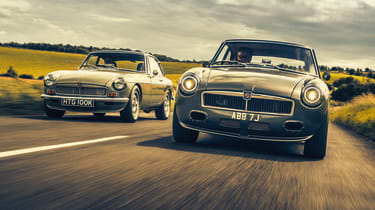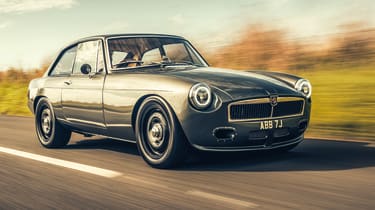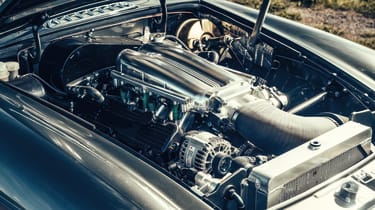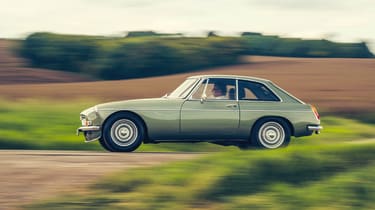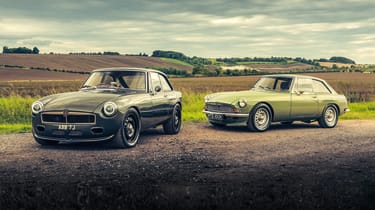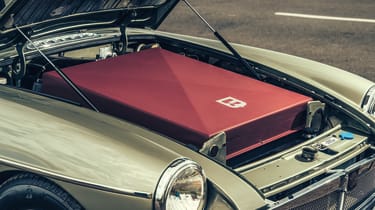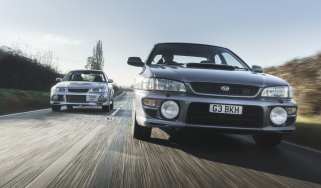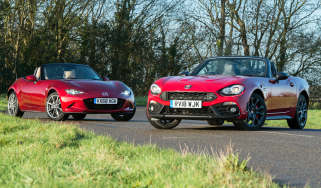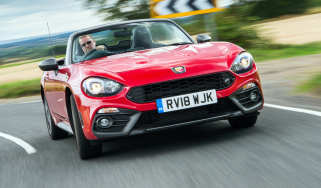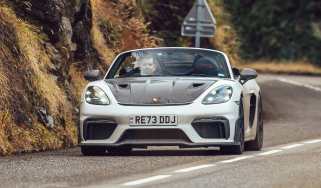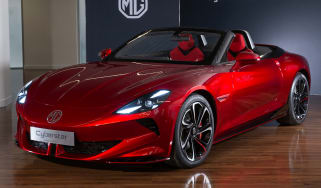Frontline LE60 v BEE GT – V8 power battles electric in MGB restomod head-to-head
MGB restomod pioneers Frontline have launched two very different new models, the fire-breathing V8-engined LE60 (right) and the battery powered BEE. We drive them both
If the burgeoning restomod scene tells us anything it’s that even the most storied classics have a few chapters left in them. Witness this pair of comprehensively reinvented MGBs from Oxford-based Frontline.
Along with Eagle and Alfaholics, Frontline can legitimately claim to be the OGs when it comes to UK restomodding. To celebrate three decades of trading, and the MGB’s 60th birthday, it has created the LE60, a limited-edition run of 30 special wide-body MGB GT coupes powered by a highly tuned 4.8-litre Rover V8.
> Volvo P1800 Cyan Racing restomod review
The LE60 is quite a thing. The crystallisation of all Frontline’s knowledge, it’s a big step up in terms of scope, ambition, performance and price point. Amazingly it’s also the first time the company has turned its attention to the V8 for one of its Factory Edition specials. At £175,000 (plus taxes) its starting price is around £50k more than for one of Frontline’s previous 2-litre and 2.5-litre four-cylinder LE50 and Abingdon Edition cars. If you’re old enough to remember MGBs being worth peanuts, such a price tag will come as a shock, but restoring and modifying a car to this extent and level of quality requires skill and devours time. In the case of the LE60, anywhere between 950 and 1050 hours of painstaking labour, not to mention a costly bill of materials.
Like all the best restomods, the LE60 is extensively reworked yet remains sympathetic to the original car. Frontline literally knows MGBs inside-out, so not only is its work beyond compare, but it’s done with a level of respect and authenticity that can only come from a group of people who are passionate about the cars they have chosen to restore and rework.
When I think of wide-body MGs, I think of the factory race cars that went endurance racing in the 1960s. Those cars wore large bubble ‘Sebring’ arches not dissimilar to those of Mk1 Escort rally cars and had a purposeful but slightly cartoonish aesthetic. Frontline could easily have gone down this route, but instead chose to discreetly pump-up the original Pininfarina-penned lines. The bodyshell and panels are made in pressed steel by British Motor Heritage (the same company that built the original factory bodyshells). It’s a much wider car, but it’s only when you park the LE60 next to a regular B that you appreciate what an increase of 6in at the front and 10in at the rear looks like. Beefy is a word that springs to mind.
De-seamed, de-bumpered and wearing period-style 16in Dunlop alloy wheels, the LE60 has plenty of presence but doesn’t try too hard to attract attention. Then again, when you have a ruddy great Rover V8 under the bonnet, you can afford to let that do the talking.
Much of the engine is new and built to Frontline’s precise requirements, with new con rods, forged pistons, roller cams, steel crankshaft and heavily reworked cylinder heads, plus electronic engine management complete with drive-by-wire throttle. It is crowned by Frontline’s own in-house-designed plenum – a work of art that takes a week of intensive work on a seven-axis CNC milling machine to carve from billet aluminium. The result? A handy 375bhp, 297lb ft and a truly fabulous-looking engine.
Consider that the LE60 weighs just 1122kg dry and it’s clear this is an MGB like no other. That thumping V8 is the trigger for a whole host of chassis upgrades, including a strengthened ’shell, Nitron adjustable coilover dampers, 310mm brake discs (by far the biggest you’ll see on an MGB), plus a five-speed Tremec gearbox with Frontline internals, limited-slip differential, new front suspension geometry, redesigned six-link mounting for the live rear axle, adjustable anti-roll bars and power-assisted steering (also adjustable).
Despite all this trick and impressively integrated hardware, the LE60 could easily feel overwhelmed by all that power and torque, especially on the damp autumnal roads experienced during our drive. Not only does it feel unusually planted, but it is underpinned by real poise. The engine is mighty, with enough firepower to really hurl the MGB down the road if you crack the throttle wide open, but it’s also nuanced enough to deliver progressively, which helps you feel your way towards its surprisingly lofty limits of traction and grip with growing confidence. It sounds fab too, a satisfying holler when driven in anger, settling back to a cultured rumble when you’re just making progress. And this despite minimal silencing on what is Frontline’s development car.
It’s a mark of how petite the regular MGB is that the wide-body LE60 is still a beautifully compact car. One that’s perfect to thread down country lanes and flowing A-roads. I’d want slightly heavier steering, but that can be dialled-in. Better, its combination of low kerb weight and large-capacity engine means you can revel in the V8’s elastic high-gear mid-range muscle, or punch through the lower gears as the mood takes you.
It’s comfortable too, which is not always a given in ’60s classics. Frontline makes its own aluminium seat frames, which are tailored to each customer and manage to look just right while offering plenty of support. As you’d expect, they are beautifully upholstered in the company’s on-site trim shop. I think I’d have my LE60 in Old English White with silver wheels and a dark green leather interior, in case you’re wondering.
The second of Frontline’s new cars couldn’t be more different. Where the LE60 celebrates the MGB in thunderous style, the Frontline MGB EV Edition, or BEE for short, grasps the nettle of EV-converted classics. To be completely honest, the notion of any battery-powered classic has always been something I’ve been inclined to reject. I say as much to Frontline’s founder, Tim Fenna, who rather takes the wind out of my sails by saying he felt much the same. Admirably, rather than sticking his head in the sand, he knuckled down and conceived an EV conversion that sits well with his enthusiast sensibilities and stays true to the modest little sports cars he loves. And, I have to say, it’s rather lovely.
From the outside you’d never guess what lurks beneath the pretty coupe body. Not for Fenna the lunacy of a quick-and-dirty Tesla swap. Instead, this development car boasts a very modest 125bhp, which is only slightly more than the output of the original MGB. Thanks in part to not cramming it with batteries, it weighs just under 1200kg (1186kg to be precise), and because that weight is distributed equally across front and rear axles, this perky little machine promises real poise.
Fenna’s holistic approach to this MG EV conversion centres upon drivetrain packaging and hardware that closely mimics the ICE-powered MGB. Lift the bonnet and you’ll find a Hyper9 100v motor and 40kWh battery pack. Where things take an even more unexpected turn is the Mazda MX-5 gearbox that hangs off the back of it. Yes, the BEE is a stick-shift manual.
The really clever bit is in the way Fenna (who is also Frontline’s chief engineer) has controlled the motor to deliver its performance in a more ICE-style manner, rather than the characteristic EV slam of instant initial acceleration. It might seem an odd thing to do, but together with the manual gearbox it strikes at the heart of what we love about the process of driving, and what EV motoring denies us.
Consequently the BEE is both a familiar and alien device to operate. The interior is a perfect snapshot of ’60s style and analogue function – you even ‘start’ it with an ignition key – but the initial driving experience is a bit counterintuitive in that you don’t need to feed in the hard-wearing ceramic paddle clutch when pulling away or coming to a halt. In fact, the BEE will pull away from a standstill in first, second or third gears, thanks to a useful 162lb ft of torque.
Once up and running you need to use the clutch to shift up and down the gearbox. You can even heel-and-toe to match road and motor speed as you would in an ICE manual. There’s drivetrain noise of a kind you’d recognise, too, a rising crescendo that builds with rpm, albeit more of a whine than the kind of fruity bwarrp you’d expect from an otherwise period-correct B. Engagement is an over-used word when it comes to classic driver’s cars, but the physical and emotional connection you make with the BEE is both genuine and satisfying.
The BEE is not a fast car. In fact, it’s barely brisk by modern standards, as evidenced by a 0-60mph time of 8.8sec and a top speed of 120mph. All I’ll say is, don’t knock it until you’ve tried it. There’s something truly liberating about being able to wind a nimble, perky sports car through the gears and not be instantly travelling at anti-social speeds. Perhaps the best way I can describe it is that driving the BEE is as close as I’ve come to feeling like I did when I first passed my driving test. It’s a truly joyful thing.
As with all EVs, trundling through towns and villages is as effortless as it is virtuous, though there’s very little creep at parking speeds so you need more throttle than you might expect to get moving. Range-wise the BEE will cover 140 miles and takes around 5.5 hours to ‘brim’ thanks to modest 7kW charging capability. That’s a long way from OEM EV range and recharge times, but it’s worth noting this is Frontline’s proof-of-concept development prototype.
Fenna says production versions will offer more like 200bhp and 200 miles of range, which will elevate performance to something close to Frontline’s four-cylinder Mazda-powered cars (which are brilliant fun, btw) and broadens the BEE’s use-case from weekend warrior and short commuter to something you might take for longer journeys or a weekend away.
As ever with cars of this nature, cost is the limiting factor. Frontline is quoting £120k (plus taxes) for the BEE – the same as for its four-cylinder cars – but bare ’shell nut-and-bolt restorations don’t come cheap. Besides, Frontline’s unique concept really does set it apart from the more basic EV swaps out there.
Look beyond the price and there’s gentle genius to this car and the way it drives. Not only does it prove that EVs don’t have to be obscenely heavy, but it also demonstrates they don’t have to be pointlessly fast but dead behind the eyes. Uniquely, in mating the modestly powerful motor to a manual transmission, Frontline has demonstrated that it’s possible to have an EV that’s both fun and rewarding to drive.
It costs more to do than a basic EV swap and requires greater engineering effort to make it work, but not only is the result perfect for EV converted classics, but the cadence, control and involvement of working up and down a well-chosen set of gear ratios proves it’s possible to bring added depth and dimensions to the otherwise one-dimensional EV driving experience. OEMs take note.
I arrived at Frontline expecting to fall in love with the LE60 and be at best unconvinced by the BEE. To my surprise, while the V8-powered LE60 contemporises all the things I love about ’60s classics, it’s the BEE (and the hardware that underpins it) that leaves the lasting impression. Quirky it may be, but I defy anyone to drive it and not be genuinely entertained and intrigued by its alternative vision of future four-wheeled fun.
Specs
| Frontline LE60 | Frontline BEE GT | |
| Engine/motor | V8, 4800cc | 100v motor and 40kWh battery |
| Power | 375bhp @ 6200rpm | 125bhp (see text) |
| Torque | 297lb ft @ 4200rpm | 162lb ft |
| Weight | 1122kg dry (339bhp/ton) | 1186kg (107bhp/ton) |
| 0-60mph | 3.6sec | 8.8sec |
| Top speed | 160mph | 120mph |
| Basic price | £210,000 | £144,000 |
This story was first featured in evo issue 316.
